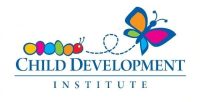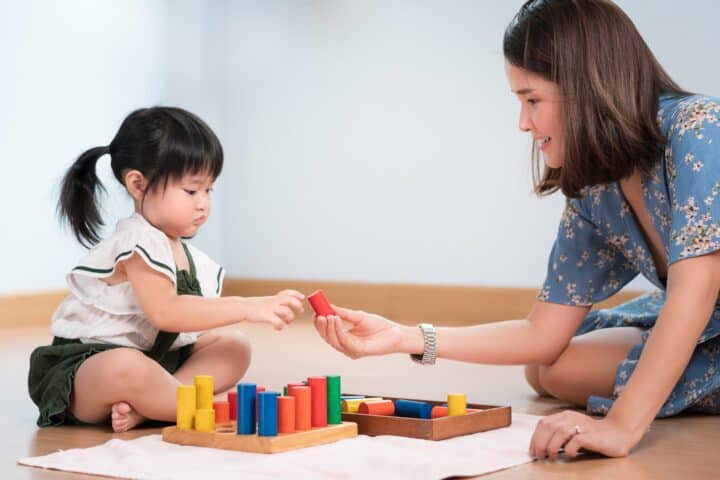
| Milestone | Description | Approximate Age |
| Early object permanence. | Follows an object out of sight, searches for a partially hidden object. | 4-8 months |
| Object permanence | Searches for an object completely hidden from view | 9-12 months |
| Cause and effect | Realizes his/her action causes another action or is linked to a response | 9 months |
| Functional use of objects | Realizes what objects are used for | 12-15 months |
| Representational play | Pretends to use objects functionally on others, or dolls | 18 months |
| Symbolic play | Uses an object to symbolize something else during pretend play | 2-3 years |
| Pre-academic skills | Knows letters, numbers, shapes, colors, and counts | 3-5 years |
| Logical thinking | Understands conservation of matter, multistep problem-solving; realizes there can be differing perspectives | 6-12 years |
| Abstract thinking | Able to hypothesize, think abstractly, draw conclusions | >13 years |
- Sensorimotor stage (birth-2 years)
- Preoperational stage (2-7 years)
- Concrete operational stage (7-12 years)
- Formal operational stage (12 years and older)
A Few Things Parents Can Do To Promote Cognitive Development
- The best thing parents can do is play with your kids (baby to teens) doing things that you both enjoy.
- Introduce your child early to music. Sing to them and with them. Play different kinds of music in the background while you are playing with your baby. Get your child a play music set. Teach them to play the key board. Take them for music lessons. We highly recommend the Yamaha Program which starts kids out a preschool but goes all the way to high school. They learn music theory, how to play instruments and how to write their own music. Go to concerts for kids.
- Introduce your children to art. Crayons and other art materials should be available. Young Rembrandt’s has a national directory for art classes.
- Spend time with younger children reading to them. When they can read on their own, encourage reading and discuss with them about they are reading. Ask questions.
- Play games with your child starting with “pat a cake” and moving on to card games and board games. Have a family game night.
- Encourage your child to get outdoors. Exercise and fresh air are good for brain development. Take them to the park, the beach or the forest.
- Go on nature walks and talk about what you see. Get books or information on things of interest. Watch TV shows on topics they are interested in and talk about it later. Here are the top 12 Tv channels for kids: Discovery, Animal Planet, Science Channel, History Channel, Nickelodeon, Nick Jr, The Learning Channel, Disney Channel, PBS, and Sprout.
- Introduce them to the local library. Get the card. Talk to the children’s librarian for book recommendations for your child. Also, ask about the programs they have for children.
- Check with your local community college and department of recreation and parks for special programs they have for kids and teens.
- Go to museums of all kinds and any other attractions around you.
- Take trips to places you can have fun and be out in nature or visit cultural or historical centers.
- Let them play with things around the house. Bring a box or two home and watch they can do.
- Select toys with play value (they can make believe, build things, learn things) and that are age appropriate. Amazon has a great toy department that provides excellent tools to select the right toys for your child.
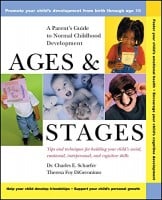
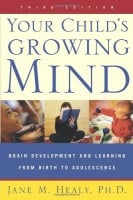
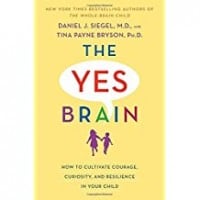
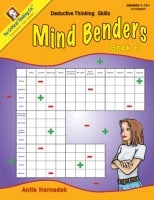
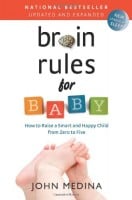
Gymboree Series On Activities for Children We highly recommend this series for parents because the books provide numerous “how to do it” play activities to nurture (provide the scaffolding) child development. From babies to young children they cover cognitive, language, physical and social development. Not only will these activities stimulate development but build a strong parent and child relationship. Plus they are fun for both parents and kids.
- Developmental Play At School: Fun And Essential For Learning!
- Why Puzzles Are Good for Your Child’s Development
- Why You Should Get Involved in Your Child’s Activities, Hobbies, and School
- Why Playing Hide-and-Seek is Good for Your Child
- Toys That Help Children Develop Spatial Skills, Creativity, and Social Skills
- Two Activities That Will Help Wire Your Child’s Brain For Learning
- Smart Eating: 6 Brain-Boosting After-School Snacks for Kids
- Improving Reading For Children and Teens
- Resources For Parents of Gifted Children
- “Play Is The Work of the Child” Maria Montessori
- Toys Great For Allowing Creativity To Blossom
- How to Support Your Child’s Creative Side
- 8 Tips for Getting Your Kids Out Into Nature
- Children are Little Scientists: Encouraging Discovery Plan
Cognitive Developmental Mile Stones:
- Listens attentively to sounds and voices (by 1 month)
- Cries deliberately for assistance (by 1 month)
- Coordinates eye movements (by 2 months)
- Discovers hands and feet as an extension of self (by 3 months)
- Likes to repeat enjoyable acts (by 4 months)
- Recognizes and responds to name (by 5 months)
- Studies objects intently (by 6 months)
- Recognizes and responds to own name.
- Discriminates between familiar and unfamiliar faces.
- Demonstrates happiness and unhappiness with sounds.
- Demonstrates memory by waiting while feeding is prepared and stopping crying when a person enters a room.
- Looks forward to feeding by sight.
- Anticipates events (by 7 months)
- Finds hidden objects (by 10 months)
- Can point to body parts
- Puts nesting toys together correctly
- Develops expectations about familiar events
- Waves bye-bye
- Follows simple directions.
- Searches for an object that has disappeared.
- Pours objects out of a container and puts each back in.
- Imitates actions of others.
- Understands basic cause and effect relationships (touching hot stove burns hand).
- Enjoys the repetition of events.
- Enjoys picture book for a short period of time.
- Assembles simple nesting toys.
- Identifies family members in photographs
- Enjoys cause and effect relationship
- Is able to make choices between clear alternatives
- Begins to solve problems
- Remembers more
- Learns by exploring.
- Responds to simple directions.
- Points to familiar objects upon request.
- Remembers where things are in different areas of the house (room).
- Hunts for a hidden toy.
- Shows brief interest in a picture book
- Gives a mechanical toy to the caregiver to activate
- Places a large round shape in a form board.
- Sorts shapes and colors
- Mimics adult behavior
- Points to and names objects
- Refers to self by name
- Learns by helping
- Learns concepts such as size, shape, and weight as he/she moves and plays with objects in the environment.
- Points to body parts upon request.
- Acknowledges absence of familiar persons (points to the door, says gone).
- Points to and names objects in a book.
- Begins to recognize shapes.
- Enjoys cause-and-effect relationships (banging drum, turning on TV).
- Follows simple instructions.
- Asks names of objects.
- Identifies more objects with names
- Comprehends size
- Beginning to understand time sequences (e.g. before lunch)
- Matches shapes and colors
- Counts and manipulates objects
- Is beginning to think about consequences
- Is able to concentrate for longer periods of time
- Follows simple directions.
- Enjoys reciting fingerplays, nursery rhymes, and songs.
- Repeats radio and TV commercials.
- Responds to rhythms.
- Learns simple relationships such as big and small.
- Invents simple sentences to express thoughts.
- Uses names of familiar people and objects.
- Asks names of objects.
- Is curious about how things work.
- Begins to understand the reasoning of caregivers.
- Interested in size and shape.
- Identifies colors.
- Counts from one to ten.
- Counts two or more objects.
- Asks why questions.
- Responds to how questions.
- Learns the name, address, phone number, sex, age and parents names.
- Holds up fingers to indicate age.
- Uses bathroom words and laughs.
- Enjoys doing things for self.
- Develops a better understanding of cause and effect.
- Distinguishes between fact and fiction
- Comprehends special concepts (e.g. around, in front, high, next to)
- Rote counts up to 2
- Can complete a 6-8 piece puzzle
- Begins to understand time concepts
- Understands simple math concepts
- Recalls main details of a store
- Improves their ability to reason.
- Knows birthday.
- Identifies coins such as penny, nickel and dime.
- Understands seasons.
- Begins to understand the need for rules.
- Understands the concept of texture, size, distance, and temperature.
- Forms logical conclusions.
- Enjoys games that test abilities.
- Improves their ability to remember past events.
- Has difficulty understanding time.
- Learns right from wrong.
- Accepts rules, but doesn’t always understand the reason.
- Enjoys routines.
- Exhibits increased attention span and concentration.
- Follows instructions concerning numbers.
- Understands terms like more than and less than.
- Uses many words without understanding definitions.
- Understands simple. classifications such as groups of trees and animals.
- Places blocks and nesting toys in order (small to large).
- Asks a lot of questions, especially, “Why?”
- Asks more complex questions.
- Desires detailed answers.
- Shows unusual interest in numbers.
- Accepts and understands rules.
- Exhibits longer attention span.
- Likes active, competitive games.
- Enjoys simple games such as checkers and cards.
- Draws symbolic pictures.
- Understands the value of coins.
- Enjoys hobbies and collections.
- Likes to experiment.
- Enjoys playing with dolls, blocks, and tools.
- Recognizes problems and can work out solutions.
- Draws conclusions from what is seen.
- Learns to generalize and draw conclusions.
- Is interested in factual information.
- Enjoys group projects such as science and art.
- Likes to construct things.
- Enjoys learning experiences involving pets.
- Applies math concepts to daily life.
- Spends long periods of time working on hobbies and crafts.
- Has increased memory and thinking
- Becomes more abstract.
- Understands the value of money.
- Growing capacity for abstract thought
- Mostly interested in present with limited thought to the future
- Intellectual interests expand and become more important
- Deeper moral thinking
- Continued growth of capacity for abstract thought
- Greater capacity for setting goals
- Interest in moral reasoning
- Thinking about the meaning of life
